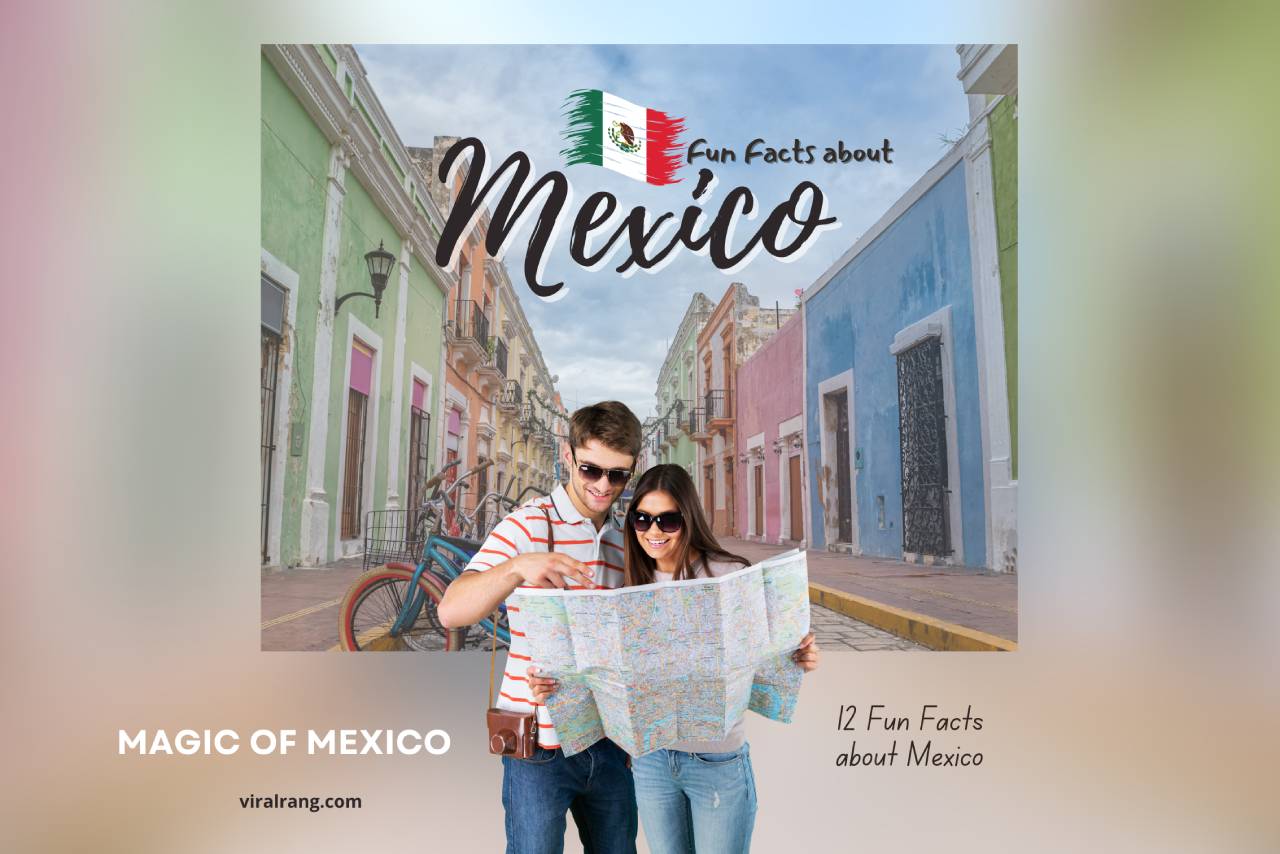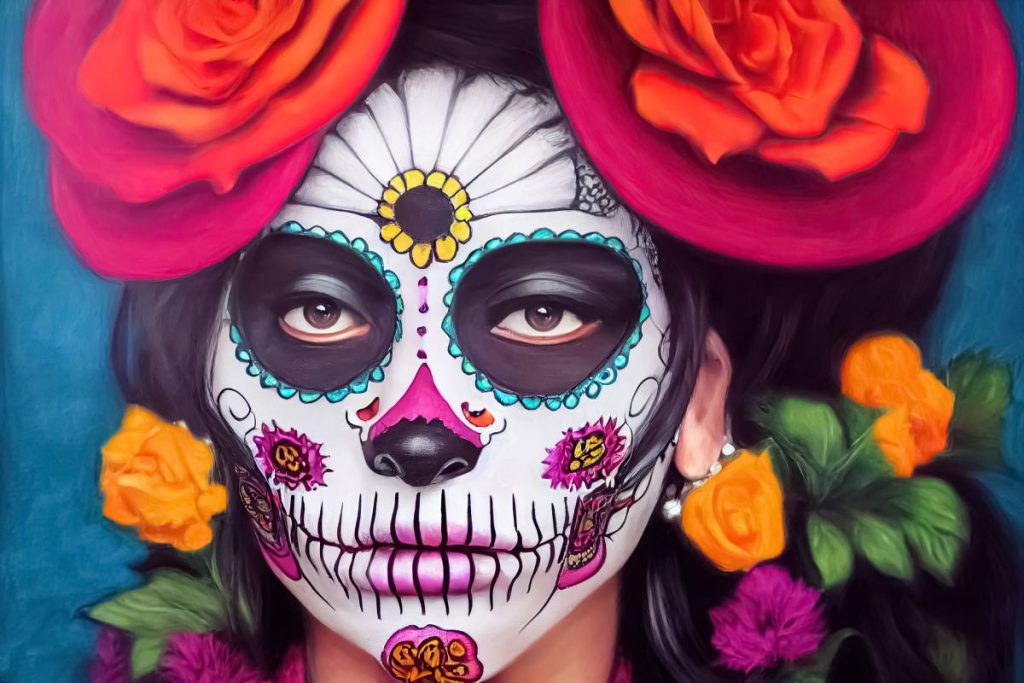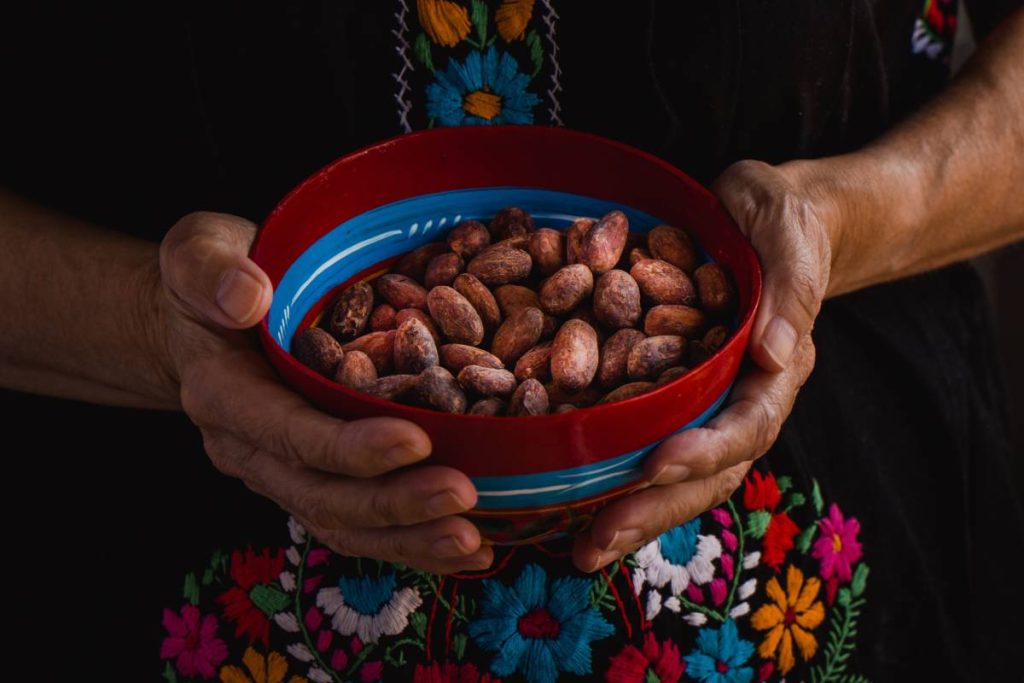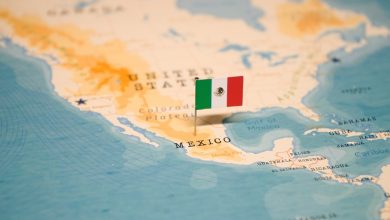
Mexico, a country known for its vibrant culture, rich history, and mouth-watering cuisines, has many more secrets to be revealed. Today, we’re going to take a deep dive into some fun facts about Mexico that will surely leave you amazed and intrigued.
1- Second-Largest Coral Reef
The Mesoamerican Reef System along the Caribbean coast is the world’s second-largest reef, stretching about 1,000 kilometers across Mexico, Belize, Guatemala, and Honduras. This breathtaking underwater wealth full of diverse species, including turtles and Mexican whale sharks, is a diver’s paradise.

One of the most captivating fun facts about Mexico is that it is home to the second-largest coral reef in the world. The Mesoamerican Barrier Reef stretches for over 1,000 kilometers, starting from the tip of the Yucatan Peninsula down through the Caribbean coasts of Belize, Guatemala, and Honduras. This underwater marvel is a sanctuary to an incredible diversity of marine life, including the endangered Mexican whale sharks, vibrant coral species, and hundreds of fish varieties.
Its sheer beauty and ecological significance make it a must-visit for divers and snorkelers from around the globe, eager to explore the hidden wonders beneath the waves. The reef not only showcases Mexico’s natural beauty but also highlights the country’s commitment to preserving its marine biodiversity.
2- Home to 68 Recognised Languages
Despite the significant Spanish-speaking population, Mexico officially recognizes 68 languages, 63 of which are indigenous. This linguistic diversity is a testament to the nation’s rich cultural heritage.
Another fascinating aspect of Mexico’s rich cultural tapestry is its linguistic diversity. With a staggering 68 recognized languages, Mexico stands as a testament to the resilience and vibrancy of its indigenous cultures.
Most of these languages belong to the indigenous peoples, each telling its own story of the country’s complex history and traditions. This multilingualism goes beyond simply communication; it is a critical part of Mexico’s national identity, embodying the country’s deep-rooted respect for diversity and heritage.
The fact that 63 of these languages are indigenous highlights the government’s efforts to preserve and respect the linguistic heritage, ensuring that these voices are not lost in the overwhelming tide of globalization. It serves as a reminder of the importance of preserving linguistic diversity in the face of a rapidly changing world, making Mexico a unique destination for those interested in experiencing the world’s rich cultural mosaic.
3- A Hub for Museum Lovers
With an astonishing 170 museums, Mexico City ranks second in the world, only falling behind London. Some of the outstanding ones include the National Museum of Anthropology and the Frida Kahlo Museum.
Mexico City, often regarded as the cultural heart of Mexico, holds the distinguished title of having the second-highest number of museums in the world. This fact alone propels the city into an enviable position on the global stage, second only to London.
With over 170 museums, visitors and locals alike are blessed with an unparalleled array of choices, ranging from the monumental National Museum of Anthropology — which houses the largest collection of ancient Mexican art — to the intimate Frida Kahlo Museum, also known as the Blue House for its cobalt-blue walls. This abundance of museums not only showcases the rich tapestry of Mexican history and art but also serves as a testament to the country’s dedication to preserving and celebrating its diverse cultural heritage.
Whether you’re a history buff, art aficionado, or simply curious, Mexico City offers an endless adventure of discovery, making it a must-visit destination for anyone looking to immerse themselves in the depth and breadth of human expression.
4- 35 UNESCO World Heritage Sites
Mexico proudly hosts 35 World Heritage Sites, underscoring its historical and cultural richness.
Among the countless marvels that Mexico offers, one of the most remarkable is its collection of 35 UNESCO World Heritage Sites. This prestigious designation is a testament to the country’s rich tapestry of natural landscapes, historical monuments, and ancient cities that span centuries of history and culture.
From the archaeological wonders like the pre-Columbian city of Teotihuacan, with its majestic Pyramids of the Sun and Moon, to the historic center of Mexico City and Xochimilco with its Aztec canals, each site offers a unique glimpse into the past and present of this vibrant nation. The diversity and significance of these sites highlight Mexico’s role as a custodian of some of the world’s most important cultural and natural treasures, showcasing a heritage that transcends borders and generations.
Whether you are a nature lover, history enthusiast, or culture seeker, the UNESCO World Heritage Sites in Mexico promise an unforgettable journey through the heart and soul of this captivating country.
5- The Day of The Dead’s La Catrina Was Created as a Satire
The iconic La Catrina image, a notable symbol for the Day of The Dead celebration, was initially designed as a satire by Jose Guadalupe Posada.

One of the most iconic symbols of Mexico’s Day of the Dead (Día de los Muertos) is La Catrina, the elegantly attired skeleton that has become synonymous with the holiday. However, many people may not know that La Catrina was created as a form of social satire. In the early 20th century, Mexican illustrator José Guadalupe Posada crafted La Catrina as a critique of Mexican society’s emulation of European aristocracy. His skeletal figure was dressed in the fine clothing of a wealthy woman, a stark contrast to the reality of most Mexicans of the time.
This creation was a commentary on the idea that regardless of wealth or status, death equalizes everyone in the end. Over time, La Catrina has evolved from a satirical figure into a beloved symbol of the Day of the Dead, celebrated across Mexico and beyond. Her image serves as a reminder of the holiday’s deeper messages about honoring and remembering the deceased, and the cycle of life and death.
6- Largest University in Latin America
The National Autonomous University of Mexico (UNAM) is not only the largest in the country but also in Latin America. It’s famed for its extensive research and influence in the higher education sector.
Another astonishing fun fact about Mexico that solidifies its place on the global stage is that it is home to the largest university in Latin America – the National Autonomous University of Mexico (UNAM). Established in 1910, UNAM is not only renowned for its expansive campus and extensive student body but also its significant contributions to research and academia. It’s a beacon of knowledge that attracts scholars from all over the world, embodying the rich intellectual heritage of the country.
With an array of faculties offering diverse programs, from arts and humanities to science and technology, UNAM represents the pinnacle of higher education in the region. Its commitment to fostering academic excellence and innovation underscores Mexico’s dedication to nurturing intellectual growth and development, making it a pivotal institution in the realm of Latin American education.
7- Pre-classical Ruins in the Middle of a Park
Chapultepec Park in Mexico City stands as a testament to the country’s ancient civilizations, with ruins dating back to the Mesoamerican pre-classical period.
Nestled within the bustling life of modern Mexico lies a gateway to its ancient past, offering a tantalizing glimpse into the Mesoamerican Pre-Classical period. The mesmerizing park, teeming with ruins that whisper tales of civilizations long gone, stands as a testament to Mexico’s deep historical roots and its reverence for preserving the past. These ruins, remnants of a time when powerful cultures thrived, allow visitors an unparalleled opportunity to walk through history, touching the very stones that were once part of extensive cities and ceremonial centers.
This harmonious blend of natural beauty and ancient architecture provides a unique, immersive experience that connects the present with the echoes of ancient times. It’s not just a park; it’s a celebration of Mexico’s enduring legacy and a profound statement of its cultural heritage, making it an essential destination for anyone fascinated by the mysteries and marvels of early Mesoamerican civilizations.
8- A Flag Full of Symbolism
The Mexican flag’s three vertical stripes signify hope, unity, and the blood of national heroes. The notable symbol of an eagle devouring a snake on a cactus has a legendary tale attached to it related to the founding of Tenochtitlan, the present-day Mexico City.

Among the multitude of fascinating aspects of Mexico is its flag, which is replete with deep symbolism and national pride. The Mexican flag, featuring three vertical stripes of green, white, and red, is more than just an emblem of the country; it’s a narrative of Mexico’s past, present, and future.
At the center of the flag lies the national coat of arms, depicting an eagle perched on a prickly pear cactus with a snake in its beak and talon. This powerful image is steeped in ancient Aztec mythology, representing the story of the founding of Tenochtitlán, the Aztec capital, which later became Mexico City.
The green stripe symbolizes hope and prosperity, the white represents peace and unity, and the red stands for the blood of the national heroes who fought for Mexico’s independence.
Together, these elements weave a story of resilience, sacrifice, and hope, making the Mexican flag a symbol of great pride and a reminder of the country’s rich cultural heritage and enduring spirit.
9- Volcanoes and Mythology
The country is home to the Iztaccíhuatl and Popocatépetl volcanoes, both steeped in the mythology of the Tlaxcala people.
One captivating chapter in the treasure trove of fun facts about Mexico is the intertwining of volcanoes and mythology, a narrative that paints the country’s dramatic landscapes with strokes of mythic grandeur. Among these, the tales of Popocatépetl and Iztaccíhuatl stand out, breathing life into the volcanic peaks that dominate the skyline.
According to ancient legend, Popocatépetl, a brave warrior, and Iztaccíhuatl, a beautiful princess, were lovers whose tragic fate was sealed by deceit and a warrior’s untimely death in battle.
In grief, Iztaccíhuatl died of a broken heart. The gods, moved by their story, turned them into mountains, with Popocatépetl forever watching over his beloved, signaled by the occasional plume of smoke that suggests his smoldering love. This tale not only enriches the vistas of Mexico but also weaves the country’s natural wonders with threads of passion, sorrow, and eternal love, vividly illustrating how mythology can breathe life into the natural world.
10- Mexico Brought Chocolate to Europe
Mexicans have been cultivating cacao trees for over 3,000 years. It was only after the Spanish conquest of the Aztec Empire that chocolate made its way to Europe.

Perhaps one of the most delectable contributions to the world, and a fun fact that sweetens the story of Mexico’s global influence, is its gift of chocolate to Europe. Long before chocolate became a global obsession, it was revered as a drink among the ancient Mesoamerican civilizations, including the Aztecs and Mayas, who cultivated cacao trees and transformed the cacao beans into a chocolate drink.
Not merely a culinary delight, this bitter chocolate beverage was esteemed for its nutritional and aphrodisiac qualities, often reserved for warriors, nobility, and the gods. The seismic cultural exchange began with the Spanish conquest of the Aztec Empire in the 16th century, leading to cacao beans crossing the Atlantic.
It was in Spain that sugar was added to the bitter brew, transforming it into the sweet delicacy that would captivate palates across Europe. Thus, Mexico’s ancient love for chocolate paved the way for it to become the beloved global staple it is today, intertwining Mexican heritage with the world’s chocolate affair.
11- Home to One of The World’s Largest Pyramids
The Great Pyramid at Cholula is the world’s largest by volume. So enormous that when the Spanish conquered the city, they mistook it for a hill!
Adding to the tapestry of Mexico’s remarkable contributions to the world is the fact that it is home to one of the world’s largest pyramids, the Great Pyramid of Cholula. Nestled in the state of Puebla, this architectural marvel surpasses even Egypt’s Great Pyramid of Giza in volume.
The pyramid, known to the locals as Tlachihualtepetl (meaning “artificial mountain”), has a base four times larger than Giza’s and stands at a height of 55 meters. Encapsulating the ingenuity and spirit of the pre-Columbian civilizations, the pyramid’s vast network of tunnels and rooms reveal the complex religious and cultural practices of the ancient peoples who built it.
Often overlooked in favor of its more famous cousins in Teotihuacán or the Mayan pyramids of the Yucatán Peninsula, Cholula’s pyramid serves as a silent guardian of history, its layers telling stories of the many civilizations that have risen and fallen in Mexico’s rich and tumultuous past.
This monumental pyramid is not only a testament to the architectural prowess of ancient Mesoamericans but also highlights Mexico’s deep-rooted and diverse cultural heritage that continues to fascinate the world.
12- Mexicans drinking more Coca-Cola than anyone else
In an exploration of fun facts about Mexico that might leave many surprised, the country’s unparalleled consumption of Coca-Cola stands out as a remarkable phenomenon. Mexico leads the world in per capita consumption of this iconic beverage, with the average Mexican drinking more Coca-Cola products than any other nation.
This phenomenon is not merely about a preference for soda but is intertwined with complex factors, including Coca-Cola’s aggressive marketing strategies, the beverage’s perceived status symbol, and, in some remote areas, the unfortunate reality of easier access to soda than clean drinking water. This staggering consumption rate also reflects the broader social and health implications, considering the challenges Mexico faces with obesity and diabetes.
Yet, this unique aspect of Mexican life paints a vivid picture of how global brands can become deeply integrated into the fabric of a country’s daily life and culture, illustrating the intersections between consumption habits and societal norms.
Conclusion
To sum it up, Mexico is a delightful blend of natural wonders, historical richness, cultural diversity, and culinary delights. But this is just the tip of the iceberg! There’s so much more to discover and explore in this mesmerizing country.
So, why wait? Plan your next adventure with Civitatis and uncover the charm of Mexico that captivates hearts worldwide.
In wrapping up this vibrant mosaic of facts, it becomes evident that Mexico is not merely a country with a rich historical palette and natural beauty, but a land that vibrates with stories, innovation, and a profound cultural depth that has influenced the globe.
From the mythic grandeur of its volcanoes to the international love affair with chocolate; from standing at the foot of the world’s largest pyramid to witnessing the remarkable consumption of a global beverage, Mexico showcases a diverse and captivating tapestry that continues to enchant and intrigue.
Each fact shared is a thread in the larger narrative of Mexico’s global contributions and cultural heritage, a testament to its enduring spirit and vibrant heart. Mexico’s story is a compelling reminder of how tradition and modernity can weave together to create a nation that is as diverse as it is beautiful.

